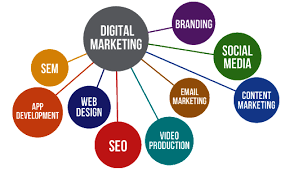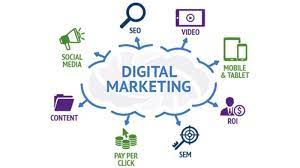Search Engine Marketing (SEM) is a vital component of digital marketing. It involves the use of paid advertising to increase visibility and drive traffic to a website. SEM is essential for businesses looking to reach their target audience quickly and effectively.
The primary goal of SEM is to improve a website’s ranking on search engine results pages (SERPs). This is achieved through the use of paid search advertising, also known as pay-per-click (PPC) advertising. PPC ads are displayed at the top of SERPs, above organic search results. They are triggered by specific keywords and phrases that users enter into search engines.
One of the most significant advantages of SEM is its ability to deliver immediate results. Unlike Search Engine Optimization (SEO), which can take months to produce visible results, SEM can drive traffic to a website within hours or days. This makes it an excellent choice for businesses looking for quick wins or those with time-sensitive promotions.
Another advantage of SEM is its targeting capabilities. With PPC advertising, businesses can target specific demographics, locations, and even devices. This allows them to reach their ideal audience and maximise their return on investment (ROI).
However, there are some challenges associated with SEM that businesses need to be aware of. One such challenge is managing costs. PPC advertising can be expensive, particularly if you’re bidding on highly competitive keywords. Businesses need to have a clear understanding of their budget and goals before embarking on an SEM campaign.
Another challenge with SEM is staying up-to-date with changes in search engine algorithms and best practices. Google regularly updates its algorithms, which can impact the effectiveness of PPC campaigns. Businesses need to stay informed about these changes and adjust their strategies accordingly.
In conclusion, SEM plays a crucial role in digital marketing by helping businesses increase visibility and drive traffic to their websites through paid advertising. While there are some challenges associated with SEM, it remains an essential tool for businesses looking to reach their target audience quickly and effectively. By understanding the benefits and challenges of SEM, businesses can create effective PPC campaigns that deliver results.
SEM in Digital Marketing: Answers to 5 Commonly Asked Questions
- What is SEM in digital marketing?
- How can I use SEM to increase my online visibility?
- What are the advantages of using SEM in digital marketing?
- What are the best practices for successful SEM campaigns?
- How can I measure the success of my SEM campaigns?
What is SEM in digital marketing?
SEM, which stands for Search Engine Marketing, is a form of digital marketing that involves the use of paid advertising to increase visibility and drive traffic to a website. It involves the creation and management of PPC (pay-per-click) campaigns, which are ads that appear at the top of search engine results pages (SERPs) when users search for specific keywords or phrases.
The goal of SEM is to improve a website’s ranking on SERPs and increase its visibility to potential customers. Businesses bid on specific keywords and phrases that are relevant to their products or services. When someone searches for those keywords, the business’s ad appears at the top of the page, above organic search results.
One of the most significant advantages of SEM is its ability to deliver immediate results. Unlike Search Engine Optimization (SEO), which can take months or even years to produce visible results, SEM can drive traffic to a website within hours or days. This makes it an excellent choice for businesses looking for quick wins or those with time-sensitive promotions.
Another advantage of SEM is its targeting capabilities. With PPC advertising, businesses can target specific demographics, locations, and even devices. This allows them to reach their ideal audience and maximise their return on investment (ROI).
However, there are some challenges associated with SEM that businesses need to be aware of. One such challenge is managing costs. PPC advertising can be expensive, particularly if you’re bidding on highly competitive keywords. Businesses need to have a clear understanding of their budget and goals before embarking on an SEM campaign.
Another challenge with SEM is staying up-to-date with changes in search engine algorithms and best practices. Google regularly updates its algorithms, which can impact the effectiveness of PPC campaigns. Businesses need to stay informed about these changes and adjust their strategies accordingly.
In summary, SEM is an essential component of digital marketing that involves paid advertising through PPC campaigns aimed at increasing visibility and driving traffic to a website. By understanding how SEM works, businesses can create effective campaigns that deliver results.
How can I use SEM to increase my online visibility?
Using SEM can be an effective way to increase your online visibility and drive traffic to your website. Here are some steps you can take to use SEM to your advantage:
- Conduct keyword research: Start by researching the keywords and phrases that are relevant to your business and target audience. Use tools like Google’s Keyword Planner or SEMrush to identify high-volume, low-competition keywords.
- Create compelling ad copy: Your ad copy should be engaging and persuasive, highlighting the benefits of your product or service. Use strong calls-to-action (CTAs) to encourage users to click on your ads.
- Set a budget: Determine how much you’re willing to spend on PPC advertising and set a daily or monthly budget accordingly. Be sure to monitor your spending closely and adjust as needed.
- Target specific demographics: Use targeting options like location, age, gender, interests, and more to reach your ideal audience.
- Monitor and adjust campaigns: Regularly monitor the performance of your campaigns using metrics like click-through rate (CTR) and conversion rate. Adjust your campaigns as needed based on this data.
- Consider remarketing: Remarketing involves showing ads to users who have previously visited your website or interacted with your brand in some way. This can be an effective way to re-engage potential customers who may not have converted on their initial visit.
By following these steps, you can use SEM effectively to increase your online visibility and drive traffic to your website. Remember that SEM is an ongoing process that requires monitoring, analysis, and adjustment over time for optimal results.
What are the advantages of using SEM in digital marketing?
There are several advantages of using Search Engine Marketing (SEM) in digital marketing, including:
- Increased visibility: SEM allows businesses to appear at the top of search engine results pages (SERPs), which increases their visibility to potential customers. This can lead to increased website traffic and brand awareness.
- Targeted advertising: SEM allows businesses to target specific keywords, demographics, locations, and even devices. This targeting ensures that ads are displayed to the most relevant audience, increasing the chances of conversion.
- Immediate results: Unlike Search Engine Optimization (SEO), which can take months to produce visible results, SEM can drive traffic to a website within hours or days. This makes it an excellent choice for businesses looking for quick wins or those with time-sensitive promotions.
- Measurable results: SEM provides businesses with measurable results through tools such as Google Analytics. This allows them to track their return on investment (ROI) and adjust their strategies accordingly.
- Cost-effective: While PPC advertising can be expensive, businesses have control over their budget and can set daily limits on ad spend. This ensures that they only pay for clicks or impressions that are likely to result in conversions.
- Competitive advantage: SEM allows businesses to compete with larger companies by appearing at the top of SERPs for targeted keywords. This gives them a competitive advantage and helps level the playing field.
In conclusion, SEM is a powerful tool in digital marketing that offers several advantages for businesses looking to increase visibility and drive traffic to their websites through paid advertising. By understanding these benefits, businesses can create effective PPC campaigns that deliver measurable results and help them achieve their marketing goals.
What are the best practices for successful SEM campaigns?
Successful SEM campaigns require careful planning, execution, and ongoing optimization. Here are some best practices to keep in mind when creating and managing your SEM campaigns:
- Conduct thorough keyword research: Use tools like Google Keyword Planner to identify relevant keywords and phrases that your target audience is searching for. This will help you create targeted ad campaigns that reach the right people.
- Write compelling ad copy: Your ads should be concise, clear, and compelling. Use strong calls-to-action (CTAs) to encourage users to click on your ads and visit your website.
- Use targeted landing pages: Ensure that the landing pages you’re directing users to are relevant to the ad they clicked on. This will help increase the chances of conversion.
- Set clear goals: Define what you want to achieve with your SEM campaign, whether it’s increasing website traffic, generating leads or sales, or building brand awareness.
- Monitor performance regularly: Keep a close eye on key performance indicators (KPIs) such as click-through rates (CTR), conversion rates, and cost per click (CPC). Use this data to optimize your campaigns for better results.
- Test different ad formats: Experiment with different ad formats such as text ads, display ads, and video ads to see what works best for your business.
- Stay up-to-date with industry trends: Keep up-to-date with changes in search engine algorithms and best practices for SEM campaigns. Attend industry events and read industry publications to stay informed.
By following these best practices, businesses can create effective SEM campaigns that deliver results and help them achieve their marketing goals.
How can I measure the success of my SEM campaigns?
Measuring the success of your SEM campaigns is essential to determine their effectiveness and make informed decisions about future campaigns. Here are some key metrics you can use to measure the success of your SEM campaigns:
- Click-Through Rate (CTR): This metric measures the number of clicks your ad receives divided by the number of impressions it receives. A high CTR indicates that your ad is relevant and engaging to your target audience.
- Conversion Rate: This metric measures the percentage of people who click on your ad and complete a desired action, such as making a purchase or filling out a form. A high conversion rate indicates that your ad is effectively driving qualified traffic to your website.
- Cost Per Click (CPC): This metric measures how much you pay for each click on your ad. A low CPC indicates that you are getting good value for money from your SEM campaign.
- Return On Ad Spend (ROAS): This metric measures the revenue generated from your SEM campaign compared to the cost of running it. A high ROAS indicates that your campaign is generating a positive return on investment.
- Quality Score: This metric measures how well Google rates the relevance and quality of your ads, keywords, and landing pages. A high Quality Score can lead to lower CPCs and higher ad rankings.
- Bounce Rate: This metric measures the percentage of visitors who leave your website after viewing only one page. A high bounce rate can indicate that visitors are not finding what they are looking for or that there are issues with your landing page.
By tracking these metrics, you can gain insights into how well your SEM campaigns are performing and make data-driven decisions about future campaigns. It’s important to monitor these metrics regularly and adjust your strategy as needed to maximise the effectiveness of your SEM campaigns.



